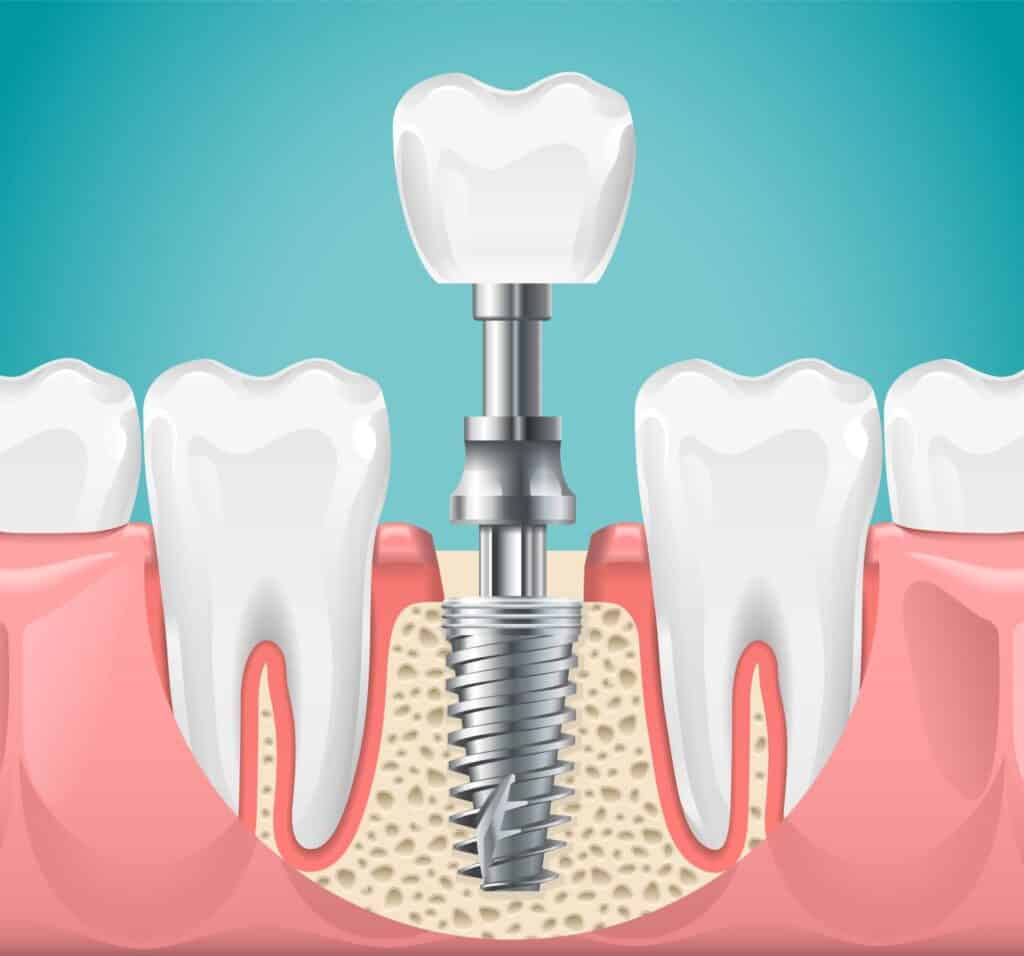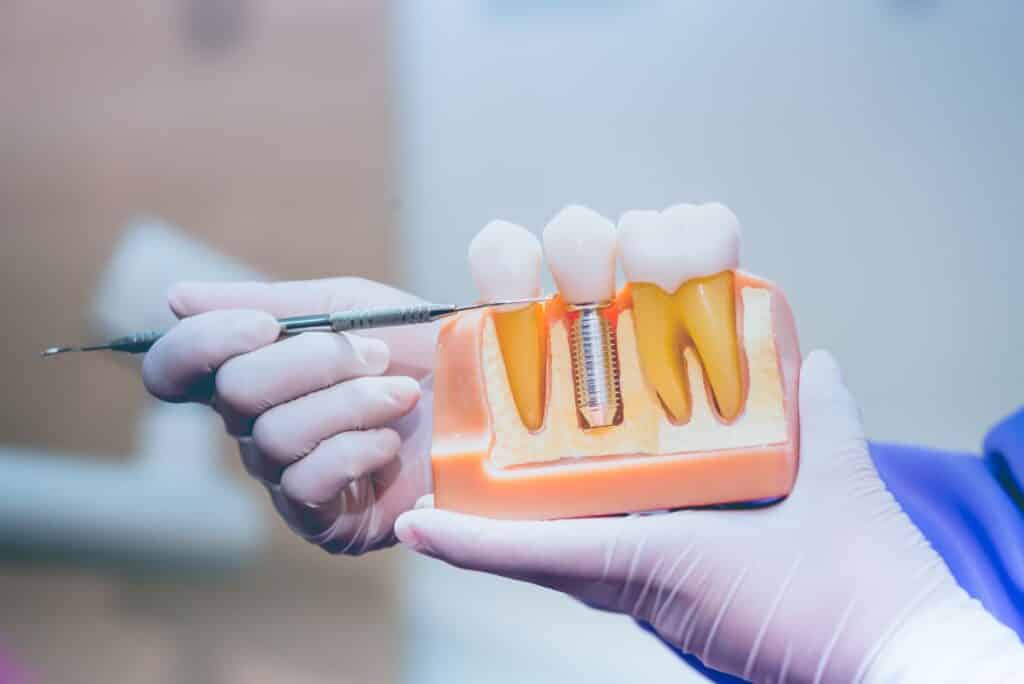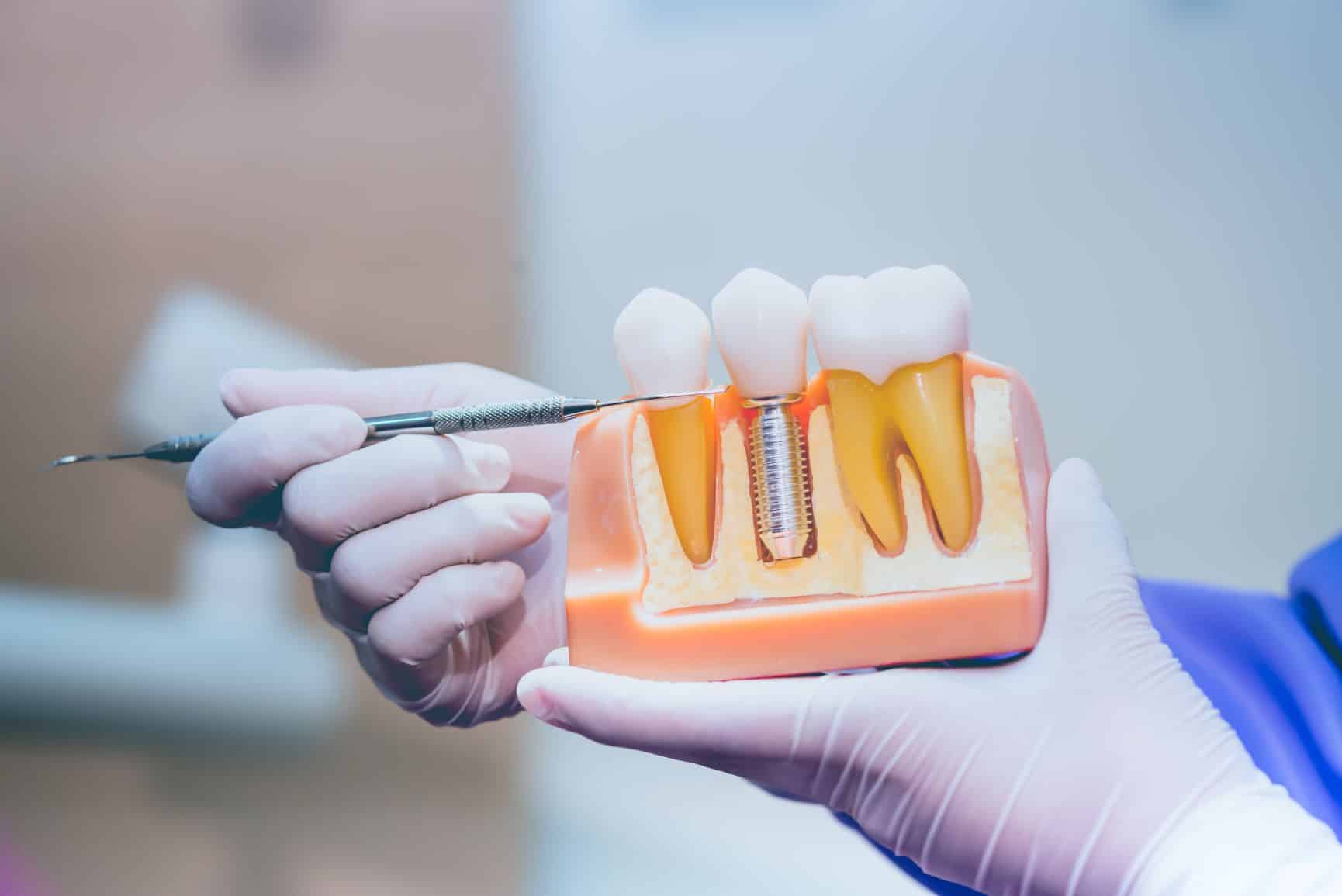As humans, imperfections are fundamental to our very nature; everything about us is subject to erosion. One such area that’s especially prone is our mouths, and more specifically, our teeth and orthodontic structure.
This degradation and subsequent loss of teeth is treatable in a variety of ways, but dental implants tend to be the preferred method. Even with this, nothing is without its risks and benefits. In this article, we take a look at the different varieties, advantages, and of course, risks associated with getting dental implants.
But first, what exactly are dental implants?
The simplest way to understand dental implants is to think of them as false teeth. They are used in place of your original teeth and function just as any ordinary teeth would. They look just like regular teeth, but don’t have nerve endings, so you can’t feel them as you would normal teeth.
People get dental implants for all kinds of reasons. Sometimes, it’s that somebody has lost teeth in an accident and needs them to be replaced. Other times, excessive cavities or bad teeth alignment might be the cause. Cosmetic reasons are also becoming increasingly popular.
As advanced as modern dental implant technology is, the practice can be traced back to ancient civilizations like Egypt. When teeth were missing, the Egyptians would insert carved shells or stones into the gum to replace them. The earliest recorded evidence of dental implants dates back to 600 AD, after archaeologists in Honduras discovered evidence of them in the Mayans. (1)
Since the early days of primitive practices associated with dental implants, the popularity has increased alongside technological and anesthetic advancements. Studies from US-based National Health and Nutrition Examination Surveys found that from 1999 to 2016, the prevalence of dental implants in those who were missing teeth rose from approximately 0.7 to 5.7%. (2)

Different kinds of dental implants
There are two main kinds of implants: endosteal and subperiosteal. While both have intimidating names, they are nothing to be afraid of and are relatively simple to understand.
Endosteal implants are designed to look just like a regular tooth that matches your teeth, sitting comfortably in your jaw and mouth. They are typically made from a mix of porcelain and titanium, and sit comfortably where your tooth/teeth used to be.
The titanium lower part of the endosteal implant is like a narrow screw. This is screwed into the gum and jawbone that sits underneath the flesh. On top of this titanium plate is the porcelain tooth, and can be placed by both a regular or a cosmetic dentist.
Subperiosteal implants work on a similar principal to endosteal. They also have a titanium screw below and porcelain on the upper end, but instead of being screwed into the jawbone, they’re screwed into the gum just above the jawbone.
Subperiosteal implants are used for those whose natural jawbone is not healthy enough to sufficiently accept a deeply inserted titanium screw. It may also be a good idea for younger people, whose bones have not yet fully matured, as deeply inserted endosteal implants are not ideal for those who are still physically developing.
If your gum and jawbone are unable to support these implants, then there are ways to rebuild them to a point where they can. Some procedures to grow your gum and jaw to a sufficient size and strength include:
- Bone augmentation: For people with insufficient healthy bone in their jaw for implants, bone augmentation is the process of rebuilding your jawbone, the idea being that this will build a foundation of bone strong enough for the implants to sit comfortably in.
This regenerative surgical procedure provides a restoration to the deteriorated bone through bone grafting. Bone grafting is when a piece of healthy bone is placed with bone that requires healing. Cells from the healthy bone then join and seal with the other, both providing vital nutrients and acting as a guide back to full strength. (3)(4)
The procedure is fairly painless and not too invasive. It would be carried out by a periodontist or oral surgeon, and the bone may be sourced from the patient themself, possibly from their shin, hip, or chin. If the bone comes from another human, this is called allograft, or if it is taken from an animal, such as a cow, it’s called xenograft. (5) - Sinus lift: A sinus lift works in a similar way to a bone augmentation, but is more focused on the upper jawbone. A sinus lift increases bone between your molars and premolars. It does this by “lifting” the sinus membrane, hence its name. A piece of bone is then added to stimulate growth in this newly established space in your upper-jaw. (6)
This is common for people who are losing teeth due to old age, those whose bone is reabsorbing into the body, or those who have gum disease. It is performed by slicing into the gum tissue, raising the tissue and cutting a circle in the bone, and filling the hole with a bone graft before closing the incision. (6)
The sinus lift standard was established in 1975, by Tatum. Due to it being a structural procedure, its efficacy was contested early on, but by the 1990s it became a standardized procedure undertaken by many trained medical professionals the world over. (7)
- Ridge expansion: A ridge expansion is what might happen if the jaw isn’t wide enough to support dental implants. In this case, the ridge bone is split open so that a graft can be inserted. This graft will stimulate growth, so that the ridge widens to a point where it can facilitate the implants. Ridge expansion may sound precarious, but it has been found to be up to 98% effective in most patients. (8)
If you’re looking for the cost of all on 4 teeth replacements, check out the comprehensive guide at NSOMS which highlights the best-in-class options available.

Advantages of getting dental implants
Nobody gets dental implants just for the fun of it. We can all probably agree that having a piece of titanium inserted into your gum and jaw is not the greatest prospect in the world. So if you’re going to do it, it’ll likely be because of the numerous benefits of replacing old or missing teeth. The following is a breakdown of some of the biggest advantages of getting dental implants.
- It’s a near identical replacement: A dental implant is usually so close to the original artefact that nobody will notice the difference in your mouth. They’re stable and strong, and they fit, feel, and function exactly as regular teeth do. They also stimulate healthy bone growth in the jaw.
- They are a long-term solution: The alternative to dental implants, tooth-supported dental bridges, have been found to last roughly five to seven years. Dental implants have been found to last roughly 25 years up until the rest of your life. The latter result is, of course, dependent on the level of care that you maintain with the implants. With approximately 25% of Americans having lost all their teeth by the age of 74, dental implant technology is an important teeth replacement procedure that’s changed many lives. (9)
- You can retain a sound quality of life: Being edentulous (i.e. Not having teeth) can adversely affect your life in a number of ways. It can play on your self-confidence, restrict your social life, and make eating—one of life’s simple pleasures—an absolute nightmare. A 1979 study in the elderly found that of the edentulous residents at an aged care facility, 59% had lesions of the oral mucosa, 32% suffered from pain, and 30% had problems chewing food. (10)
- Cosmetic benefits: Your face is designed to hold teeth in it, so losing them can make it sink, sag, or droop. Dental implants act just like regular teeth, so your face can retain its natural shape and structure. This means that you can keep your smile and feel good about your appearance.
- Protect your mouth, gum, and bone health: When a tooth is removed, whether in an accident or out of necessity, it leaves an open wound and/or exposed bit of gum. This exposure can lead to infection of the wound, or deterioration of the jawbone. This is because the tooth is no longer there to protect the jawbone, and without the tooth there, that segment of jawbone loses its purpose (to hold the tooth) and deteriorates accordingly. Unlike dentures, which simply sit atop the gums, dental implants actually do the same job as natural teeth would, ultimately stimulating bone growth.
- Avoid dentures: 20th century cartoons synonymised dentures with old people, leaving children and young people without a critical assessment of their true nature. The reality is that dentures are clunky, less convenient, and less hygienic than dental implants. Dentures have the added risk of falling out when eating or speaking, while dental implants allow you to continue your regular oral health routine, such as brushing and flossing.
- Maintain your speech: The languages that we speak were developed into what they are today due to the conventional facial and oral structure that we have, including our teeth. Edentulism and/or having dentures can lead to problems with your speech, which can adversely affect your confidence and social standing. Studies have shown that only 10% of those who receive dental implants do not experience immediate improvements in their edentulate speech impairment. (11)
- Unrestricted diet: Without teeth, you’re left on a diet of soft foods. This may include things such as soups, smoothies, pureed vegetables, and lots of liquids. As texture is so fundamental to the food that we eat, this can make meal-times an underwhelming experience, as well as cancel out many of our favourite food groups. The strength and sturdiness of dental implants put the power back into your bite, giving you access to the full range of food groups, and ultimately benefitting your health.
- No more cavities: Ok, so this doesn’t mean that you should never visit the dentist, but the porcelain material in your dental implants will not be subject to cavities. Again, your oral hygiene routine (brushing, flossing, mouth wash) should continue as per usual. Remember that cleaning your mouth is partially about keeping your teeth clean, but also about gum health, the walls of your mouth, and keeping your breath fresh.

What risks are there when it comes to dental implants?
Everything has its downsides, and dental implants are no exception. Technology is moving fast, with science even at a point where growing new teeth in mice has become a reality. We are not quite at that point for humans yet, meaning that for many of us, whatever synthetic teeth options are available may be the only solution. The following is a breakdown of some of the risks involved in getting dental implants.
- Dental implants can cause infection: If an infection occurs after having dental implants inserted, it’s usually because bacteria from the mouth has entered the gum during the procedure. Another potential cause is that the implant has not been inserted properly, leaving a gap between it and the bone. This can lead to gum infection, which may result in a bleeding or swollen gum, or even a build-up of pus. In rare occasions, the bone can become infected, which may lead to deterioration. Often, this infection can be treated with a course of antibiotics.
- Your body rejects the dental implant: Some people’s bodies are not suited to having metal implanted into them. If your body has rejected piercings in the past, then it may be possible for it to reject your dental implant as well. This would result in the tooth slowly and painfully being forced out of place, as the gum and bone refuse to host the new tooth.
- Nerve damage: Sometimes dental implants can lead to nerve damage. Nerve damage can result when an implant is inserted too close to a nerve in the jawline. Some impacts of this could be numbness, or a tingling sensation in the gums, jaw, and face.
- Sinus problems: Dental implants in your upper-jaw can lead to sinus problems. This can happen when the hollow bones in our faces, called sinuses, are perforated by the dental implant. In the rare instance of this occurring, the implant will likely be removed and the bones should self-heal.
In conclusion
Dental implants have been used, in various forms, for millennia. The different varieties, endosteal and subperiosteal, have their own functions mostly differentiated by longevity. If your bones, gums, or jaw are not adequate for dental implants, then bone augmentation, a sinus lift, or a ridge widening may help to prepare you for treatment. The benefits of dental implants are many, and largely contribute to an increase in your quality of life. Although rare, there are risks, which include infections and physical damage to your face and jaw. Make sure to inform yourself properly before undertaking any kind of medical procedure.
References
- “Current trends in dental implants”, Source: https://synapse.koreamed.org/upload/SynapseData/PDFData/3070jkaoms/jkaoms-40-50.pdf
- “Trends in Dental Implant Use in the U.S., 1999–2016, and Projections to 2026”, Source:
- “Bone Augmentation Techniques”, Source:
- “Bone Grafting”, Source: https://www.hopkinsmedicine.org/health/treatment-tests-and-therapies/bone-grafting#:~:text=During%20a%20bone%20graft%2C%20your,of%20some%20other%20medical%20procedure
- “Bone Augmentation And Nerve Repositioning”, Source:
- “Sinus Lift Surgery: Answering Common Questions”, Source:
- “The sinus lift graft: basic technique and variations”, Source: https://pubmed.ncbi.nlm.nih.gov/9573843/
- “The Edentulous Ridge Expansion Technique: A Five-Year Study.”, Source:
- “Dental Implants: A Review”, Source:
- “How dental conditions handicap the elderly”, Source:
- “Speech adaptation after treatment of full edentulism through immediate‐loaded implant protocols”, Source:








